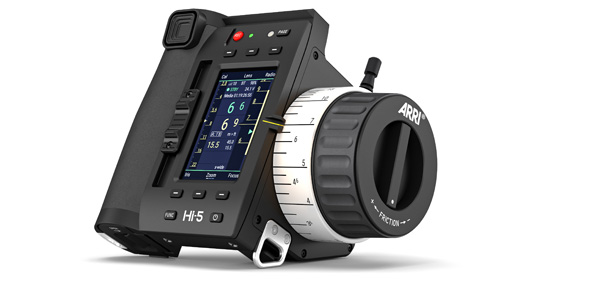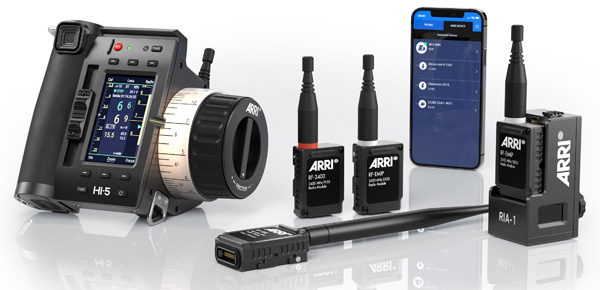
The new ARRI Hi-5 hand unit gives camera crews wireless camera and lens control on set. It comes housed in a weatherproof, solidly built device with a long distance radio signal and swappable radio modules for different territories and shooting conditions.
It replaces the earlier ARRI WCU-4 and is a major component of ARRI’s Electronic Control System ECS. Alongside the radio system, new intelligent batteries, smart focus rings and an iOS app, the Hi-5 upgrades connectivity on-set and helps simplify tasks with up to 100 virtual radio signals and immediate reconnection.
Typically, Hi-5 users will be focus pullers or 1st ACs. The Hi-5 improves on the previous unit’s ergonomics and has a high contrast display and modern touchscreen interface based on a camera GUI that will be familiar to such users. It allows full camera control including 3rd party cameras, with an operator-adjustable focus knob, three customisable user buttons and support for Focusbug Cine RT ultrasonic rangefinders.

The new iOS app, ARRI ECS Sync App, communicates between ARRI and the Electronic Control System. Users can exchange files between devices and the app, receive software updates and carry out fast lens file management tasks – saving and loading lens tables without a laptop on set. Lens files and user settings can be displayed, archived or shared.
Swappable Radio Modules
The swappable radio modules are among the first to be developed for a hand unit. Because so many devices now use the typical 2.4 GHz ISM band, and different frequency regulations exist in different countries, the ability to exchange radio modules is an advantage and means crews can choose the module that suits each shooting location.

ARRI ECS system
ARRI will release three radio modules in the 900 and 2400 MHz ranges, using direct sequence and frequency-hopping (FHSS) spread spectrum methods to cut through interference. FHSS avoids interference when transmitting radio signals by rapidly changing the frequency of the carrier between many distinct frequencies occupying a large spectral band. The available frequency band is divided into smaller sub-bands, and the signals rapidly change, or hop, their carrier frequencies between the sub-bands in a predetermined order. That way, interference at a specific frequency will only affect the signal during a short interval.
Together, the three modules cover many different shooting situations with a robust, long-range radio link, and are also backwards-compatible with existing camera equipment. As the system evolves, new modules can be added, in effect future-proofing the Hi-5 by equipping it to accommodate future standards for on-set hardware communications.

Efficiency
For reliability, the Hi-5’s housing is dustproof, weatherproof and ruggedized for operating in harsh conditions. Various design elements of the device are oriented towards efficiency. Smart pre-marked focus rings communicate directly with the Hi-5 hand unit, and are detected automatically and instantly mapped to the lens focus scale.
Batteries for the Hi-5 are ARRI products based on the NP-L interface – they can be hot-swapped without powering the unit down, and their remaining capacity is displayed precisely on the Hi-5 screen. Also, a new Tail Slate Mode prevents the user from stopping recording before capturing a tail slate, marking the shot that occurs at the end of a film, on shots that need it. Alerts for these and other situations can be set up via vibration instead of visually. www.arri.com






